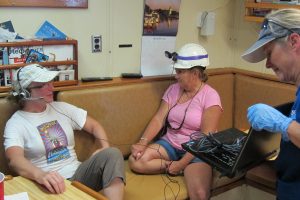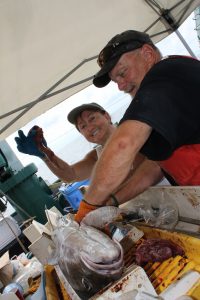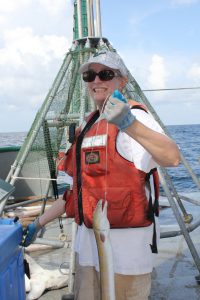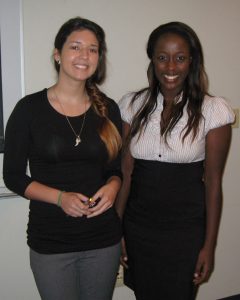Stories from the Field: The Next Best Thing to Being There
– November 8, 2012
Students, teachers, and journalists joined scientists on board research expeditions and in labs this summer and shared their experiences online. This allowed visitors from the science, education, and public communities to tag along and be a part of the exciting oil-spill research funded by the Gulf of Mexico Research Initiative (GoMRI).
Skype proved to be an effective means for teacher Patty Smukall, C-IMAGES’s first Teacher-at-Sea, to engage students with live science. In August, over 360 middle and high school students in Florida participated in seven Skype sessions with Patty and the scientists conducting fish health studies aboard the Florida Institute of Oceanography’s (FIO) RV Weatherbird II. These interactive sessions included tours of the vessel, research on deck, and interviews with scientists and crew members including the ship captain. The engaged students asked the scientists a variety of questions such as: “How long does it take to bait all of the hooks? What are people on the boat allowed to bring? What colleges did you attend and how many years did you attend?”
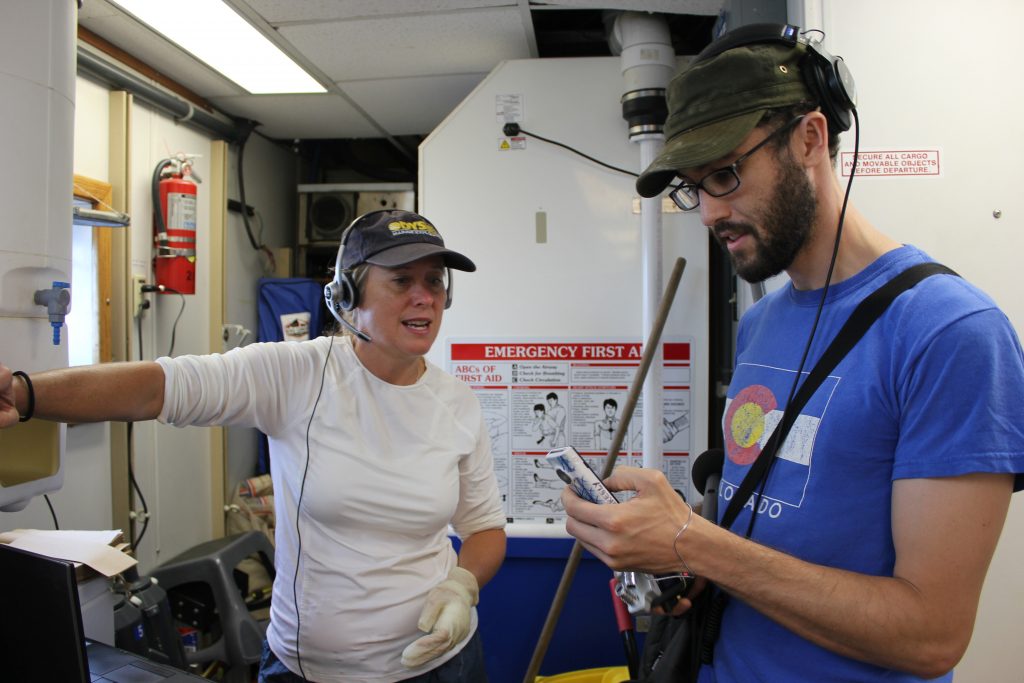
Dr. Teresa Greely and journalist David Levin hold a Skype session on board the RV Weatherbird II with teachers and middle school students at the St. Petersburg, FL Pier Aquarium during a YMCA afterschool program. (Photo credit: C-IMAGE)
Eileen Hayes, a teacher at Ida Baker High School in Florida, sent a message of appreciation to C-IMAGE coordinator Dr. Teresa Greely: “The students and I LOVED the video conferences today, and we learned so much! What a wonderful glimpse you gave us of a working research vessel! Thanks for the amazing experience that you provided for my students.”
Blogs are a popular means for researchers to share field experiences, mixed with a bit of their personalities, by using their words and pictures to tell interesting stories.
The Deep-C Voices From the Field is a rapidly expanding blog by students, teachers, and scientists studying the effects of the Deepwater Horizon oil spill on marine life. Deep-C bloggers include Drs. Stan Locker, Ian MacDonald, Amy Baco-Taylor, and Felicia Coleman.
During a Deep-C Fisheries/Ecology cruise, Dr. Coleman incorporated humor with science as shared in this post where she described weather challenges: “Between wind, waves, and a recalcitrant current . . ., we were provided with what RV Weatherbird II Captain Matt White generously called ‘opportunities for team building,’ as evidenced by the ‘how many scientists does it take to untangle a longline full of hooks‘ event.” Dr. Coleman’s blog
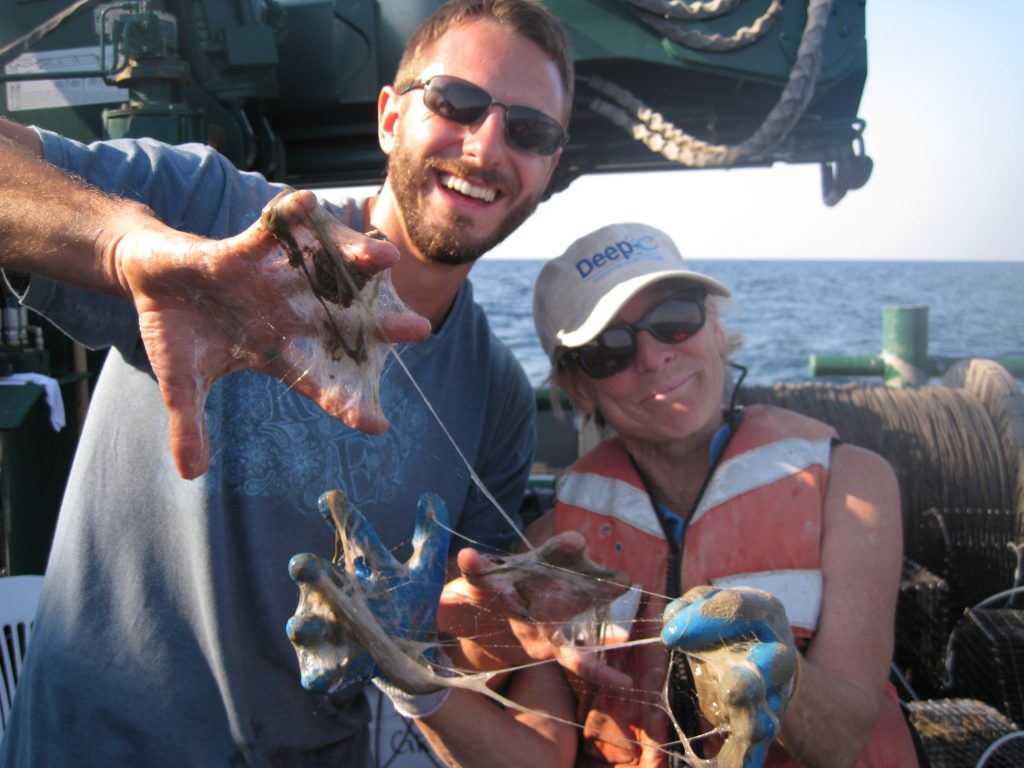
Dr. Felicia Coleman, right, blogged about an encounter with Hagfish slime shown here during the recent Deep-C Fisheries Cruise on the RV Weatherbird II. Chris Malinowski on left. (Photo credit: Deep-C)
Summer undergraduate intern Cassie Wood also blogged about research challenges faced while on board the FIO’s RV Bellows during a Deep-C Microbiology/Shelf Sampling cruise. Cassie shared her experience of seeing researchers quickly change plans in order to complete their work: “The device we were using to collect water samples failed. This was a mixed blessing because, although it was difficult to collect samples. . .the students got the rare treat of seeing how researchers collected water samples the ‘old school’ way.” Cassie Wood’s blog
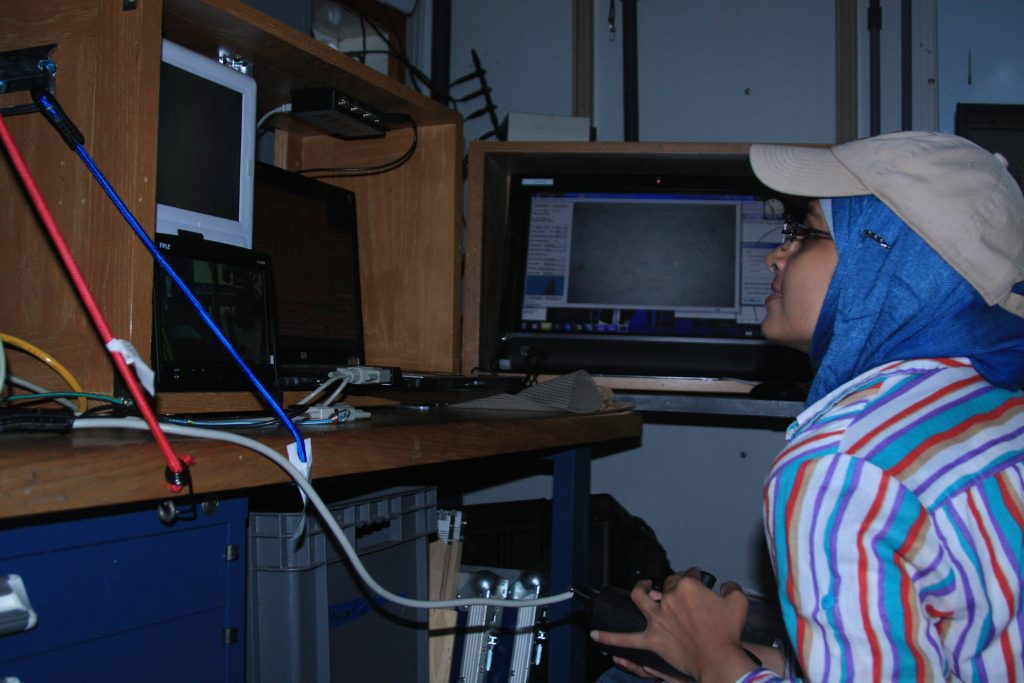
Dr. Ian MacDonald blogged about the challenges of using remotely operated equipment during a Deep-C Geomorphology/Benthic cruise on the RV Weatherbird II. Here, Ph.D. student Samira Danishgar Asl flies the MILET platform, which is hovering 2 meters above the sea bottom at the end of a 2,500 meter cable. (Photo credit: Ian MacDonald, Deep-C)
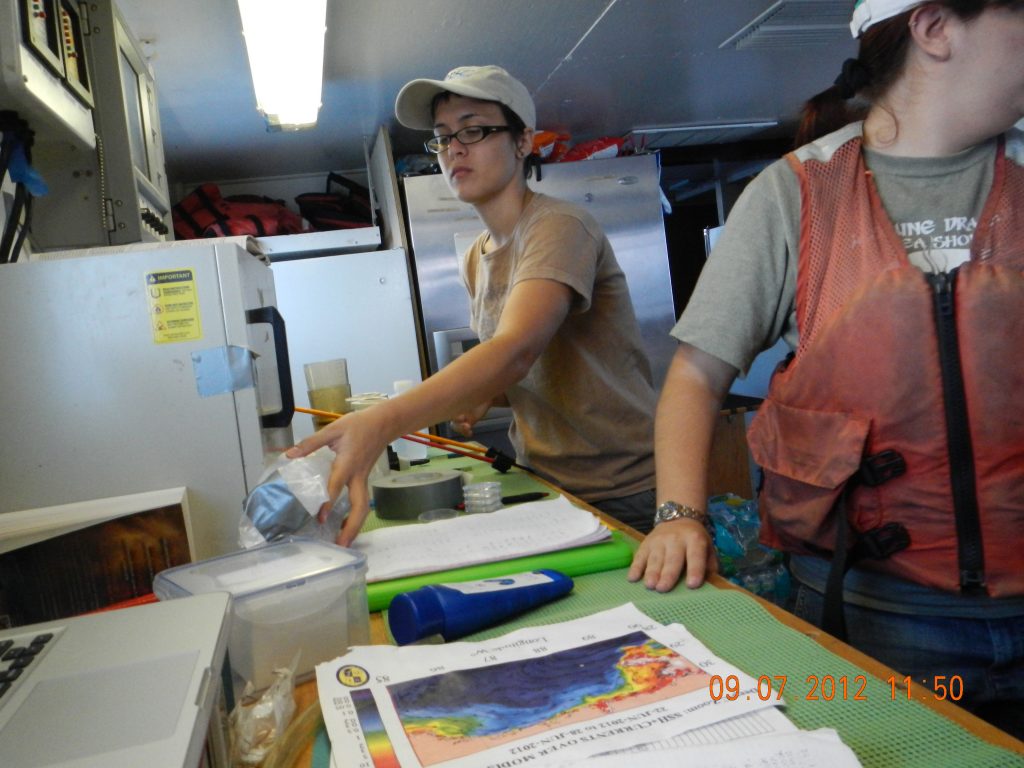
Cassie Wood, a Deep REU participant, works in the onboard lab on RV Bellows. Cassie used her blog to share her experiences as part of a five-day microbiology and shelf sampling cruise. (Photo credit: Deep-C)
The CARTHE GLAD blog features graduate student Nathan Laxague who chronicled the 17-day research expedition aboard the University of Miami’s RV Walton Smith. As part of this Grand Lagrangian Deployment (GLAD) experiment, scientists and students deployed more than 300 drifters in the Gulf to collect ocean current data.
Nathan blogged his personal reflections along with the science: Day 2 “For the first time in my life, I woke to find myself surrounded on all sides by water with no land in sight;” and Day 10 “Three hours of ripping around our drop site left us with a total of 214 transmitting GLAD units in the water. . . .this means that the Grand Lagrangian Deployment is now the largest drifter deployment experiment, well, ever. And we’ve still got about 100 more to go.”
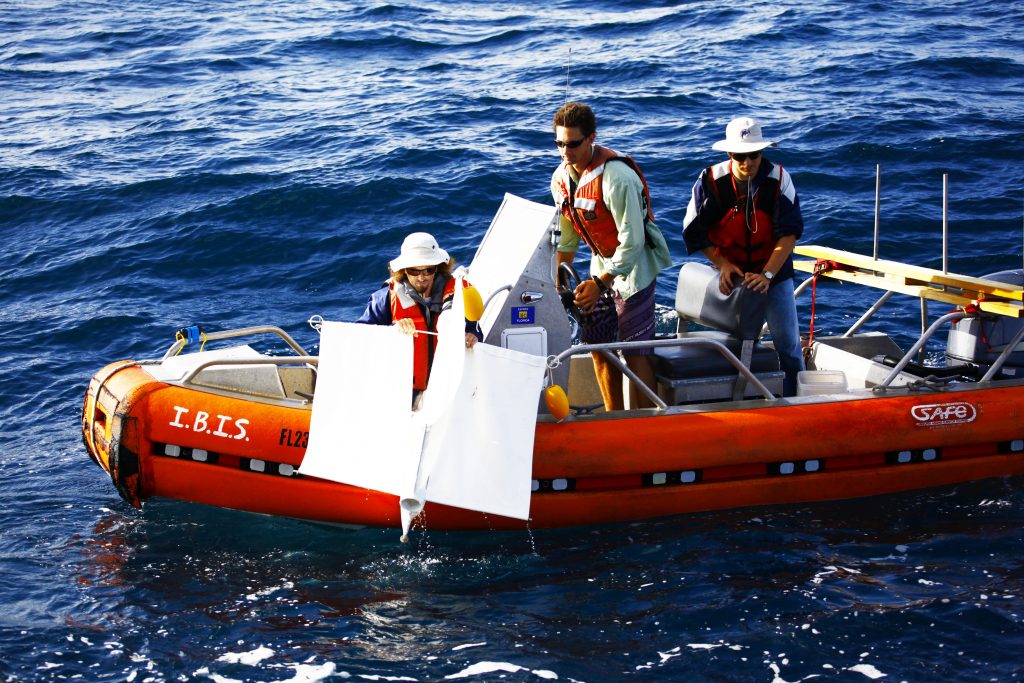
(L-R) Ph.D. students Matt Gough, Conor Smith, and Nathan Laxague launched GLAD drifters, as described on Day 6 of Nathan’s blog: “Using nothing more than our small boat’s compass and our own mariners’ intuition (with some pre-loaded GPS waypoints on a hand-held Garmin), we dotted our little patch of Gulf with a third of the payload.”
The C-IMAGE Adventures at Sea website features scientists, ship crew, students, a teacher and a journalist. Teacher-at-Sea participant Patty Smukall assisted Dr. Teresa Greely with blog posts about fish health survey work on the RV Weatherbird II. At the end of the cruise, Patty described the value of her time at sea: “It was the experience of living and working alongside these phenomenal and dedicated professionals that will have an impact on my professional development and ability to inspire my students to become the oceanographers of the future.” Patty Smukall’s blog
Dr. Jacqueline Dixon, Dean of the University of South Florida College of Marine Sciences, joined the C-IMAGE cruise. In her blog post, Dean Dixon explained why it was important for her, as an administrator, to participate in field work: “I can’t make wise decisions unless I have a firm working knowledge of what the students, staff, and faculty are experiencing.” Dean Dixon’s blog
David Levin with Open Mind Media was also on the C-IMAGE August cruise. David’s blog post reflects his journalist’s perspective: “I’ve been wielding a microphone, conducting interviews on the fly, and collecting the sounds of the ship for a series of radio pieces. . . .The Weatherbird II is a radio guy’s dream.”
The ECOGIG cruise blog features Dr. Samantha Joye, a co-Principle Investigator with ECOGIG, who has been researching the Deepwater Horizon oil spill since it began. In her blog, Dr. Joye describes how their deep sea research builds on that important initial work: “We will continue our time-series monitoring of seafloor biogeochemistry at a sub-set of the stations we’ve been tracking since the Macondo blowout. We’re sure to make some fascinating discoveries. Stay tuned!”
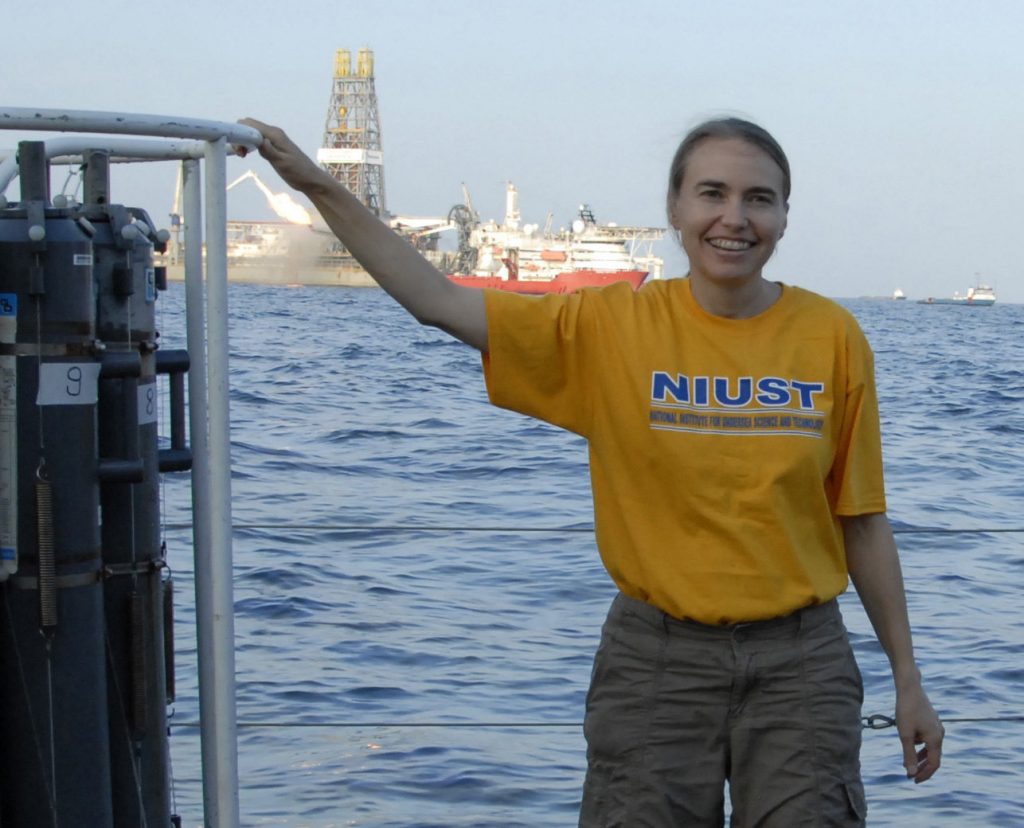
Dr. Samantha Joye’s blog includes her early research experiences related to the oil-spill as shown here with her near the site of the Deepwater Horizon while efforts were underway to cap the spill (in the background). (Photo credit: S. Joye)
ECOGIG hosted Josh Fischman, journalist with the Chronicle of Higher Education, for two weeks in June on the University of Rhode Island’s RV Endeavor. Josh gave updates on ECOGIG research as it was happening in five online posts: Lost and Found at Sea; Taking Apart the Deepwater Horizon Oil Slick; Less Sleep Equals More Oil: Science Equations at Sea; and Micro-predators and Oily Prey; Chasing the Hidden Effects of Deepwater Horizon Oil.
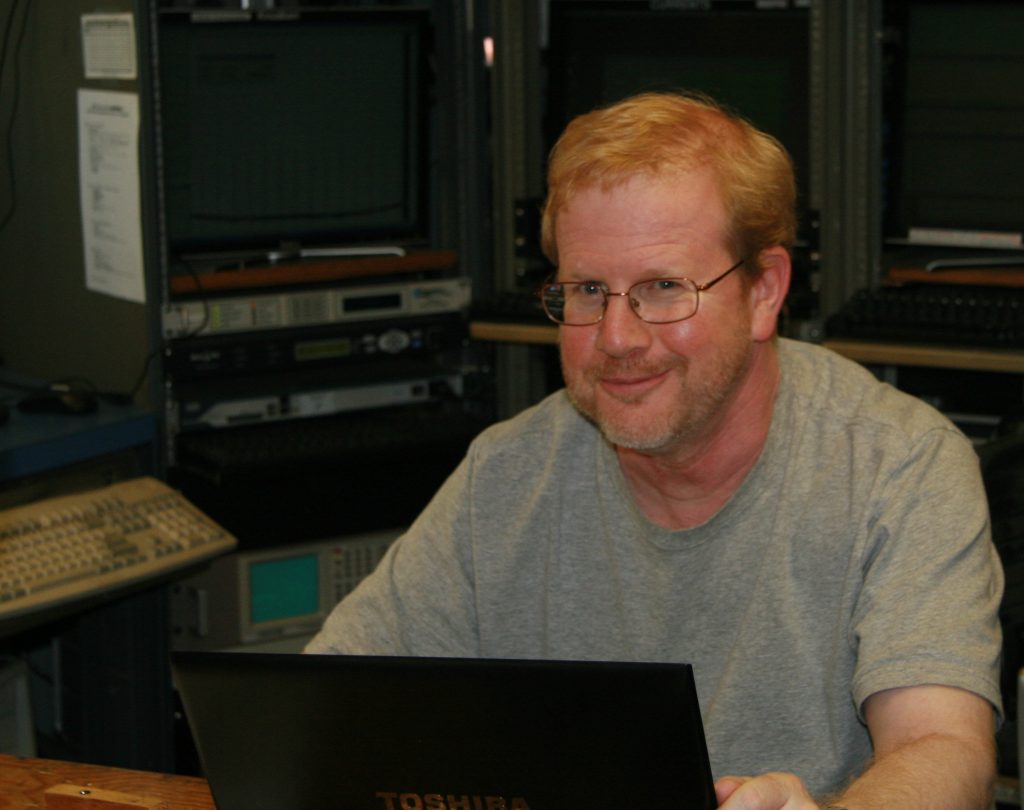
Journalist Josh Fischman at his work station on board the RV Endeavor where he prepared articles for on-line posts that described ECOGIG oil spill research. (Photo credit: Joseph Montoya)
A C-MEDS Tumblr page features the oil-degrading bacteria lab-based research of summer undergraduate interns Julie Kaiga and Rebecca Tamayo, who plan to update the site as their research continues.
We got a chance to experience another side of the oil spill that most people do not think about. Since oil spills affect a lot of people, we were hoping to inform the public in an accessible way and educate high school students in an interactive method in which they are accustomed. The site allows the public to get information without reading rigorous journals or articles. Julie Kaiga
This research is made possible by a grant from BP/The Gulf of Mexico Research Initiative. The GoMRI is a 10-year, $500 million independent research program established by an agreement between BP and the Gulf of Mexico Alliance to study the effects of the Deepwater Horizon incident and the potential associated impact of this and similar incidents on the environment and public health.
© Copyright 2010-2017 Gulf of Mexico Research Initiative (GoMRI) – All Rights Reserved. Redistribution is encouraged with acknowledgement to the Gulf of Mexico Research Initiative (GoMRI). Please credit images and/or videos as done in each article. Questions? Contact web-content editor Nilde “Maggie” Dannreuther, Northern Gulf Institute, Mississippi State University (maggied@ngi.msstate.edu).

